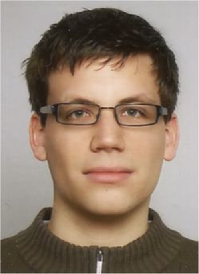Top-gating of the two-dimensional electron gas at complex oxide interfaces
Promotion date: June 19.
Promotor: Prof. dr. ir. Wilfred van der Wiel
Prof. dr. ir. Hans Hilgenkamp
| Conductivity has been shown to appear in the form of a two-dimensional electron gas (2DEG) at the interface between the transparent, insulating materials LaAlO3 (LAO) and SrTiO3(STO). The LAO needs to be deposited on TiO2 terminated STO, where a LAO thickness of at least 4 unit cells (u.c.) is required to observe conductivity. The origin of this conductivity is heavily debated. The conductivity and related properties, such as carrier density and mobility, can be tuned by adding additional top-layers on the LAO surface. Depending on the choice of materials, carrier density and/or mobility are enhanced or worsened. If the mobility is high enough, quantum oscillations and universal conductance fluctuations can be observed in magnetic field. Furthermore magnetism and superconductivity have been reported. This thesis focuses on making a top-gated device (rather than a back-gated one) in LAO/STO that would enable one to tune the properties on a more local scale, with lower gate voltages and without moving domains. For the final effect transistor: gold was used for the top-gates that was deposited directly on LAO and was evaporated via e-beam evaporation, since sputtering led to shorts. By applying top-gated voltages, the conductivity in the STO/LAO DEGs can be tuned. At low temperature the superconductivity can be enhanced by applying a gate voltage. Also an increase in spin orbit coupling strength has been deduced from measurements on the magnetoresistance. This led to a deeper understanding of the mechanisms that play a role in the rich variety of the conductivity at the interface of these complex oxides. Downscaling can allow a step towards realizing nanoscale quantum dots in complex oxides. |
Was your PhD research orientated toward fundamental research?
Indeed it was. My project was part of a FOM program, aimed towards fundamental research. This field of research - studying conductivity and other properties on complex oxides - is about ten years old now. The new approach here was to take first steps towards controlling processes and properties using top-gated voltages on these special interfaces.
Can you recall some special moments during your PhD research project?
We were the very first to control superconductivity properties. Characterizing these was a demanding task. Being able to do so was a very nice result. The control over the superconductivity could be improved even more in future, I am sure of.
In what respect did you change personally, as a researcher and scientist, in these four years?
At the start of the project I had a more following nature, now I am much more skilled in performing research independently, determining my own direction of research using a critical yet practical attitude.
Also my knowledge on this special material field has grown exponentially, virtually from scratch. Now I know how conductivity issues are researched and modeled here. I developed a fairly good intuition to try and work on building good samples and designing the right experiments.
What are your future plans?
I would like to switch towards industrial research. In academics some lines of research are not chosen on rational grounds only and publications are rewarded on reputation sometimes, in my opinion.
I guess industrial research is far more aimed at practical use, and more projects are worked on at the same instant of time. In fundamental research, such as my PhD project, I spent four years on a fairly exotic materials system that is not very likely to be used in future applications. Despite all that, I enjoyed reaching the good results and making some good contributions.
In what magazines did your articles appear?
One was published in Physical Review Letters B, another one in Applied Physical Letters. A third article is under preparation still.
What in your opinion is important for Mesa+ to stay successful in future?
The equipment available at Mesa+ is impressive. In my opinion the technicians should have a better say in the strategic lines of research to be followed. Their expertise is needed to search the limits of the apparatus, really challenging the boundaries of physics. In some cases the technician is very much more skilled than the PhD student can ever reach in his four years period. Knowing all tricks and skills, he is able to prepare the best samples needed for experimentation.

